- Editorial Offices
- 103 Brantly Hall
- Missoula, MT 59812
- (406) 243-5914
- themontanan@umontana.edu
- Icons By Maria Maldonado
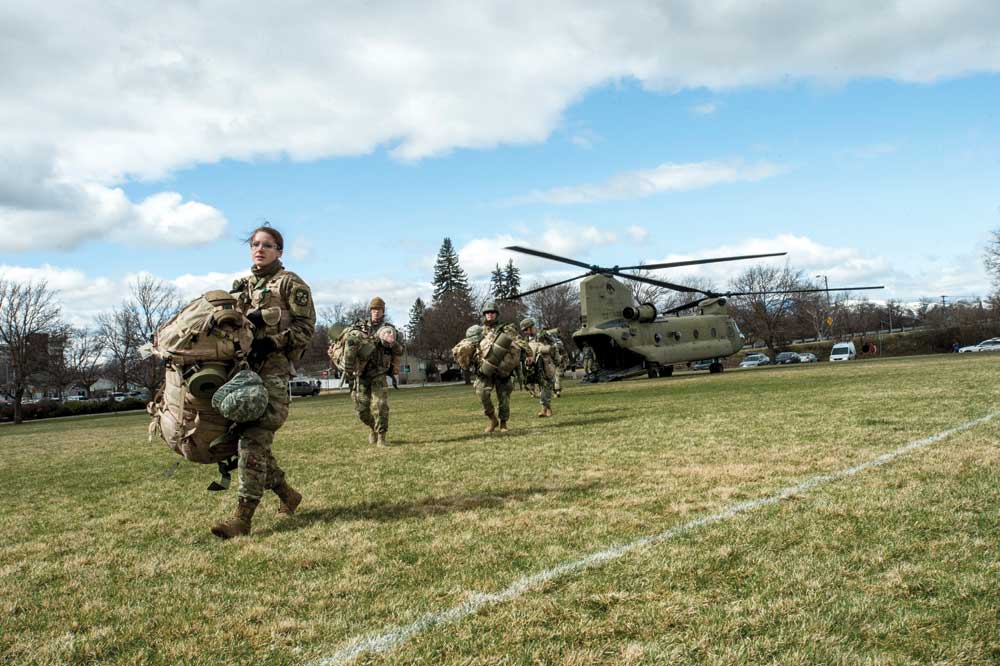
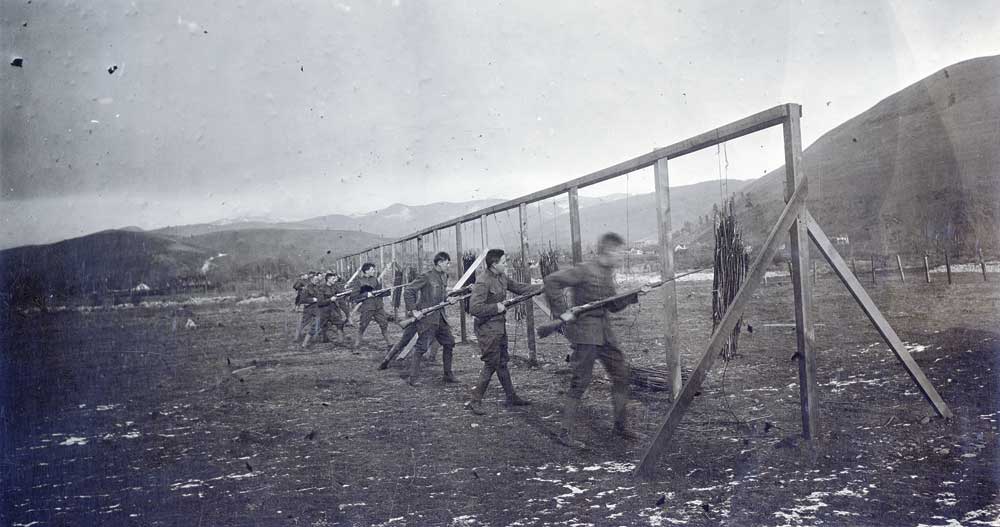

It’s an hour before sunrise on a Tuesday in April, and campus is quiet. The Oval is empty, the dorms dark. Behind the shifting clouds, a waning moon and a handful of stars hang in the velvet sky as if they were pinned there. Snowflakes drift to the ground like tiny white parachutes. Somewhere a ventilation system groans to life. And then the east doors of the Schreiber Gym swing open into the stillness.
The first thing out of the building is a guidon, a maroon and silver pennant with a Griz print, attached to a wooden pole. Behind that is the young man carrying it. He wears a Kevlar helmet, a load-bearing vest, camouflage fatigues and a rucksack filled with 35 pounds of gear. Behind him, 40 more uniformed men and women pour out of the door in identical kit. They maneuver quickly to the north, beneath the shadowy hulk of Mount Sentinel. The only sound is the murmur of their boots on the pavement. Even the birds are silent.
The men are clean-shaven. The women have their hair pulled back. They are lean and fit with a military bearing, but they are not officers – not yet. They are the cadets of Grizzly Company, UM’s Reserve Officer Training Corps. And while the rest of the University sleeps, they are doing what ROTC students do every morning: physical training.
Today’s PT is a 5-mile ruck march, which the cadets consider short. On other days they put in 10 or 12 miles. A week ago, six cadets gave up their spring break to compete in the Bataan Memorial Death March, a 26.2-mile slog through New Mexico’s high-altitude desert. Their feet are still raw and blistered.
With the guidon always at the front, the company tramps through snow over the Clark Fork River on the Van Buren Footbridge and crosses East Broadway. Bleary-eyed commuters watch them through their windshields. The cadets move at their own pace; some walk, others run. 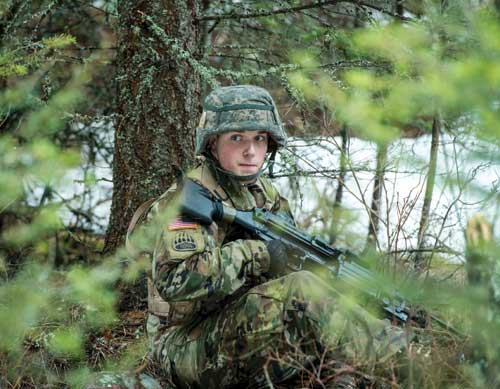 Cadet Chris Blaser is among them. A 19-year-old sophomore from Boise, Idaho, Blaser has been set on serving in the military since high school.He came to UM on a full-ride ROTC scholarship. The scholarship has conditions: He must maintain good grades, perform well in physical training and stay out of trouble. If he falls short, he’ll have to pay back the scholarship. And when he graduates, he’ll have to repay the Army with four years of service, plus two years in the reserves. Blaser is undaunted.
Cadet Chris Blaser is among them. A 19-year-old sophomore from Boise, Idaho, Blaser has been set on serving in the military since high school.He came to UM on a full-ride ROTC scholarship. The scholarship has conditions: He must maintain good grades, perform well in physical training and stay out of trouble. If he falls short, he’ll have to pay back the scholarship. And when he graduates, he’ll have to repay the Army with four years of service, plus two years in the reserves. Blaser is undaunted.
“Leadership and service have always been a big part of what I do,” he says. “I want to give back to my country. And I love the mountains. That’s why I chose the Army.”
Blaser turns off the road at a trailhead, where a path snakes up the side of Waterworks Hill. By now, other cadets are already on their way down. Blaser encourages them as they jog past.
“Good work, Paulsen!”
“Good job, Greig!”
“We’re like a big family,” Blaser explains. “We’re with each other all the time. It’s fun to be around people who are working hard alongside you.”
Blaser reaches the turnaround point, a blinking radio tower on the ridgeline. The morning sky has turned the color of chalk. Down below, the lights of Missoula sparkle. Traffic hums. Academic responsibilities await. Blaser is majoring in political science and minoring in Russian. This week he has to write an essay comparing Plato’s “Republic” with Huxley’s “Brave New World.”
But here on Waterworks Hill, he is midway into a lesson in the other half of his education – the half that is preparing him to be a lieutenant in the Army. Students like him have been training at UM to serve in the military for 100 years now. Blaser seems to relish it. His uniform matches the tawny tufts of grass poking out of the fresh snow. His cheeks are red with exertion. His eyes are bright.
“There really isn’t a better way to start your morning,” he says.
The idea of training future military officers on college campuses goes back to 1819, when Capt. Alden Partridge endeavored to create “citizen soldiers” at Norwich University in Vermont. Later, the Land Grant Act of 1862 gave each state 30,000 acres to create institutions of scientific learning. In return, these institutions offered courses in military tactics.
But the ROTC as we know it wasn’t born until President Woodrow Wilson signed the National Defense Act of 1916. World War I was raging in Europe, and the U.S. Army needed an influx of educated officers. Universities around the country stepped up to fill the need by creating military commissioning units on their campuses.
The idea stuck. Today, more than 270 Army ROTC programs operate at universities and colleges around the country, comprising the largest officer-producing entity in the military. The program’s principles are emblazoned on the black and gold ROTC shield. A lamp signifies the pursuit of knowledge. A sword represents the valor of soldiery. And a Greek helmet recalls the ancient concept of the warrior-scholar who wielded both.
UM created its ROTC program in 1918. Two years of participation was mandatory for all male students. Cadets dug trenches on campus, erected canvas tents and practiced bayonet drills between classes.
Over the years, interest in ROTC has mirrored the ebb and flow of U.S. military engagements. In the 1960s, the University ended mandatory participation in ROTC due to the protests over the Vietnam War. In the 1970s, women were allowed to join. Then in 2000, UM’s ROTC program partnered with Carroll College in Helena. Together, about 75 cadets from Grizzly Company and Saints Company make up the Grizzly Battalion.
The man commanding that battalion is Lt. Col. Chad Carlson, the son of a game warden from Big Timber. He works out of an office in a wing of the Schreiber Gym, the home of UM’s ROTC since 1926.
Carlson has short red hair and an easy smile. He was commissioned as an Army officer after graduating from the ROTC program at Gonzaga University in 1997. He served two tours in Iraq, where he specialized in the dissection and disposal of improvised explosive devices. He’s now in his 21st year of active duty and his fourth year as the leader of Grizzly Battalion.
Carlson says that while the ROTC curriculum and physical requirements have changed over the past century, the fundamental goal is the same: to create quality leaders for the Army.
“The basics of a leader are still the same,” he says. “Leadership is a team sport. You can’t be authoritarian. You have to work with everyone around you to be successful.”
Those skills make cadets successful in civilian careers, too. Not all ROTC graduates go on to active duty in the military. Some choose to go into the National Guard or the Army Reserves. Some serve their required time and start civilian careers. Whatever they end up doing, Carlson says the cadets benefit from training at a civilian university.
“They have to learn to manage their time,” he says. “They have their ROTC requirements, but they also have to do what the physics department or wildlife biology department says.”
Carlson says the University benefits as well. They get bright, driven students who graduate on time with scholarships paid by the government. The cadets enrich the campus life in other ways, too.
“It’s always good for a community to have a military presence,” Carlson says. “With no nearby military base, folks in Missoula could forget the military exists. If you lose that connection, people will stop appreciating it.”
That’s why Carlson and the other instructors – they’re called cadre – stress the importance of engagement. Cadets work parking detail during sporting events. The color guard performs at local events. And, most audibly, they fire a replica mountain howitzer cannon in Washington-Grizzly Stadium after the national anthem and every Griz score.
Carlson says he’s often impressed with the way ROTC students take risks to develop themselves. One cadet was afraid of heights, so he signed up for airborne school and learned how to jump out of airplanes.
“They are willing to challenge themselves, academically and mentally,” he says.
He also thinks the program is stronger because of its location. Cadets here conduct training exercises in real wilderness environments. The majority of cadets are from Montana, and Carlson has noticed they tend to have good situational awareness – they notice deer on the side of the road, for example. They also tend to be raised on a strong ranching and farming work ethic.
“That’s very attractive to the Army,” Carlson says. “You don’t have to teach them to work; you just have to teach them the Army.”
The Grizzly Battalion has commissioned 1,940 officers in the past 100 years. Its alumni include two three-star generals, five two-star generals and three one-star generals. There’s no telling how far the current cadets will go. That’s why it doesn’t feel like a chore for Carlson to report to Schreiber Gym before dawn each morning to meet them for PT.
“I’m just proud of them,” he says. “They’re a great group of cadets, a great group of students. It makes you feel good about the future of our country when you deal with these kids every day.” 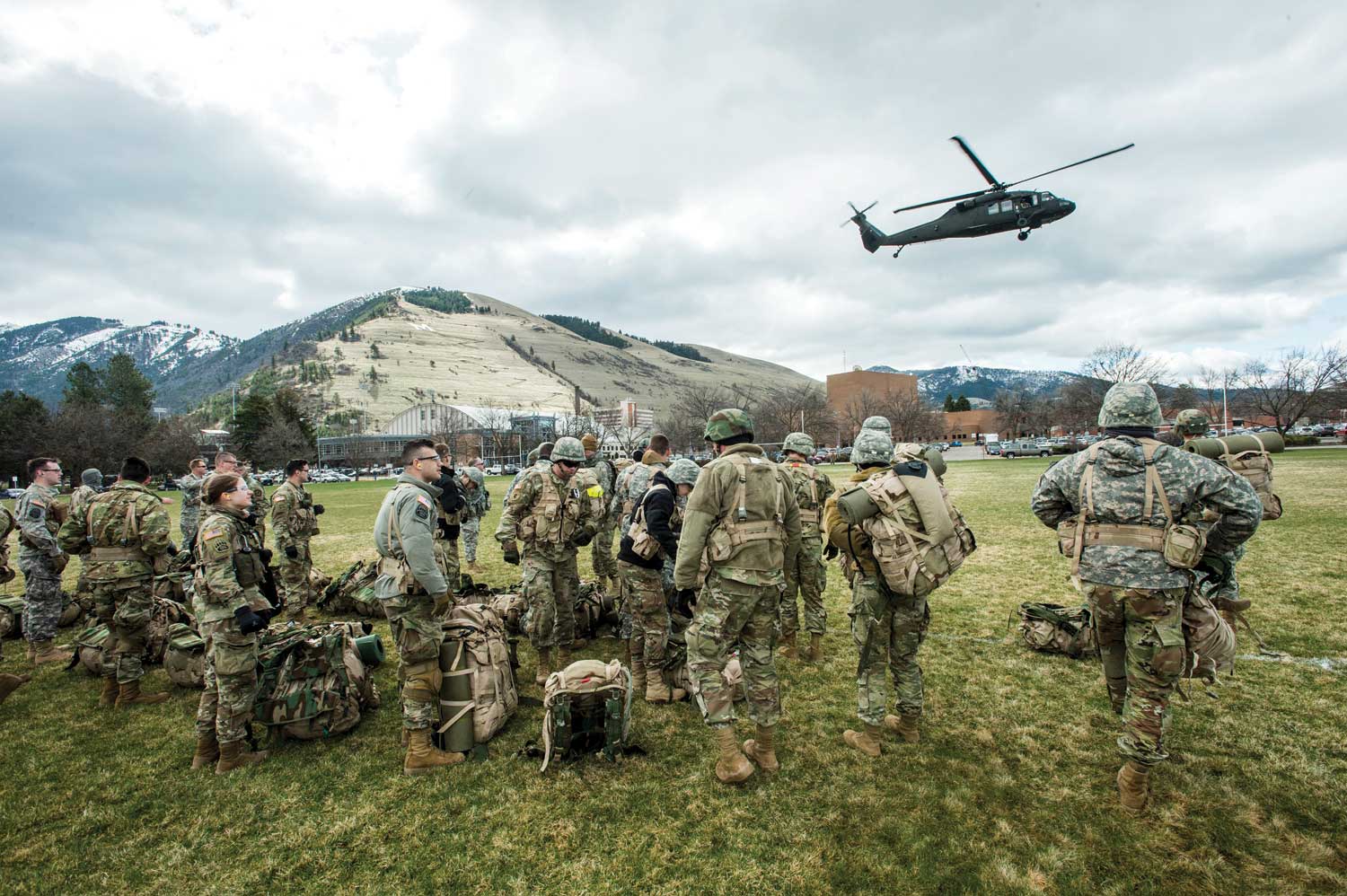
Retired Army Brigadier Gen. Colleen McGuire was once one of those kids. She grew up in Missoula and joined the Army Reserves while she was still at Sentinel High School. In 1978, in her junior year at UM, she became a cadet in Grizzly Company. The program was then 60 years old.
“It was a different culture back then,” she recalls. “The male cadets did not truly adhere to military grooming standards – this was the ’70s.”
McGuire was the only woman in her class group. She had different PT standards but otherwise she was treated like the men. “You still had to put so many rounds downrange and hit a target,” she says.
McGuire excelled at shooting. Her father served 30 years with the Army Reserve and would often take the family out into the woods for a picnic and target practice. Backpacking and navigation were second nature to McGuire, skills that came in handy during her ROTC training exercises in the hills around Missoula.
“It was really just an extension of a camping trip, with Army jargon,” McGuire says. “It was fun. I was getting college credit for this.”
McGuire was active on campus in other ways. She was a cheerleader and a member of Delta Gamma. She was an involved student in the School of Journalism. But it was the ROTC program that gave her some of her closest friends and the personal development that has reverberated throughout her life.
“I would consider it a leadership laboratory,” she says. “You get the chance to learn, experiment and grow your own leadership style in a relatively safe environment with your friends. You really get to know yourself, too.”
McGuire applied those lessons well. Upon her graduation in 1979, she had a gold bar pinned on her shoulder and became a second lieutenant in the Army’s military police. After 33 years of service, McGuire had risen to become the first woman Provost Marshal General of the Army – the chief of military police.
“It’s the pinnacle of your career,” she says. “You can’t aspire to something like that, because it’s just truly unbelievable.”
She credits her success in part to UM’s ROTC program, which gave her a civilian college experience with training that prepared her for a military career. And even though a lot has changed in the 40 years since she was a cadet, McGuire says she would do it all over again if she could.
“I admire the heck out of kids who are joining the military and ROTC now,” she says. “We weren’t facing then what we are now. It’s a different world. We really need well-balanced human beings as leaders, and I think ROTC does that.”
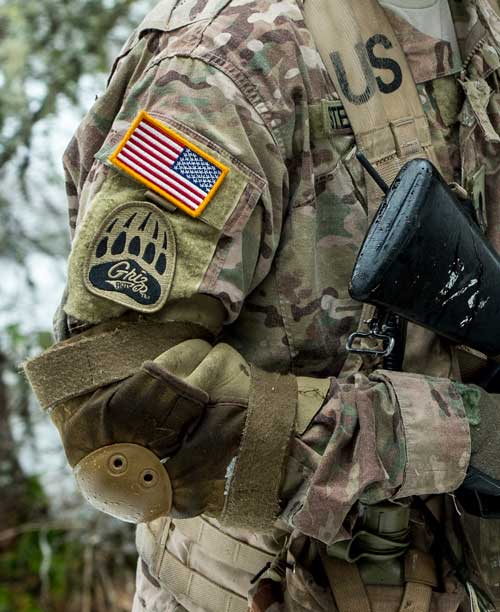 Cadet Jane Summers wasn’t feeling very balanced last spring when she found herself alone in the woods with a map and a compass, in the middle of the night. In fact, she was feeling hopelessly lost.
Cadet Jane Summers wasn’t feeling very balanced last spring when she found herself alone in the woods with a map and a compass, in the middle of the night. In fact, she was feeling hopelessly lost.
Summers, an athletic student from Arroyo Grande, California, had just joined ROTC as a sophomore and was making her first solo attempt at land navigation in Lubrecht Experimental Forest outside Missoula. Navigation didn’t come easy for her, but she had prepared for this exercise. She was in uniform, with a load-bearing vest, a backpack and a red-tinted headlamp. All the cadets had been given different coordinates to locate a small red box tied to a tree branch with a code on it. Summers had plotted her coordinates, measured the degrees on her compass, charted the distance and planned her route. But now, she couldn’t make heads or tails of the map. The trees gave up no secrets. Hours passed, and she didn’t see a single other cadet.
“The forest was dense and dark,” Summers remembers. “I was imagining the wildlife. I was definitely very frightened. I hit rock bottom.”
So she took a few deep breaths. She told herself she could do this. And she tried to figure out where she was. She found a dirt road that she couldn’t locate on the map. She followed it to an intersection and eventually returned to her starting point. She tried again and found her red box.
Summers is a junior now, majoring in exercise science. She’s also in a sorority, Kappa Alpha Theta. The cadre stresses that cadets should prioritize academics over ROTC, but Summers seems to excel at both. When she’s not studying for a statistics test or writing a paper for biomechanics, Summers is learning how to treat a collapsed lung on the battlefield. (Insert a large-bore needle above the third rib to decompress the plural sac.)
On Wednesday afternoons, she practices small-unit maneuvers in Pattee Canyon, sometimes in knee-deep snow, with all her gear and a rubber duck rifle. She also finds time to practice swimming 100 meters in her uniform and honing her accuracy with an M-9 pistol.
She has a busy summer ahead of her, too. She’ll attend Advance Camp in Fort Knox, Kentucky, a national gathering of ROTC cadets that tests the skills they’ve learned and ranks their performance. After that she’ll go to Indonesia for a cultural training with that country’s navy.
Summers doesn’t know how her career in the military will pan out. But she’s happy with the path of personal growth she’s charted with ROTC. And she’s come a long way from that night she was lost in the woods.
“I’m so much more confident with land navigation now,” she says. “I also understand that whatever you’re working through, if you take deep breaths and apply what you know, if you understand your fears but don’t let them take over, then there really aren’t many things you can’t accomplish.”

Jacob Baynham graduated from UM with a journalism degree in 2007. He writes for Outside, National Parks, and other magazines. He lives in Missoula with his wife, Hilly McGahan ’07, and their two sons.